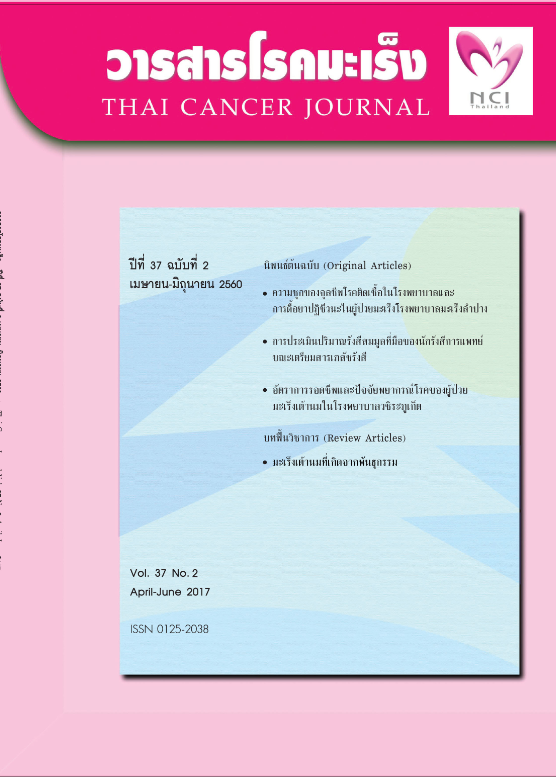Evaluation of Equivalent Dose to Technologist's Hands during the Preparation of Radiopharmaceuticals
Keywords:
hands equivalent dose, nuclear medicine workers, personal dosimeter TLDAbstract
In Thailand, the diagnostic and therapeutic uses of radiopharmaceutical preparations in nuclear-medicine centers are increasing every year. Workers preparing or administering radiopharmaceuticals are at risk of receiving high equivalent radiation doses to their hands. To date, no research has determined radiation doses among these groups of workers. This study aimed to measure radiation equivalent doses to workers' hands while preparing radiopharmaceuticals, using a thermoluminescence dosimeter (TLD), and to compare doses with those not involved in these tasks. Twelve nuclear medicine centers participated, with 19 and 13 persons in the test and control groups, respectively. TLD rings were worn on both thumbs for 2 periods of 2 consecutive weeks. The results showed that 18 persons in the test group (95%) received radiation equivalent doses of between 5.6 and 263.7 mSv/y. The average dose was 68.0+63.0 mSv/y. These results were within the 500 mSv/y dose limit recommended by ICRP 60. Variations in the dose received ranged from 1 to 52.7% of the dose limit, and resulted from different workloads among centers and radionuclide sources available at the center, e.g. a radionuclide generator or unit doses. In the control group, no radiation doses were detected in 11 persons (85%). A comparison of the two groups found that the preparation group received higher equivalent doses to the hands than the control group. The differences in doses received between the two groups were statistically significant (P =0.0004). This study, although undertaken within a short period of time, represents their working conditions and activities. The results can be used to inform the planning of protective measures compliant with the "as low as reasonably achievable" (ALARA) principle, and increasing the awareness and understanding of the importance of radiation safety standards in nuclear medicine in Thailand and elsewhere.
References
Nuclear Energy Agency Organization for economic co-peration and development. Radiation Protection. Evaluatation of ICRP Recommendation 1977, 1990 and 2007. OECD 2011. p. 42.
International Atomic Energy Agency. Safety Report Series No. 40. Applying Radiation Safety standards in Nuclear Medicine. Austria: IAEA; 2005. p. 29-40.
Ginjaume M, Carinou E, Donadille L, Jankowski J, Rimpler A, Sans Merce M, et al. Extremity ring dosimetry intercomparison in reference and workplace fields. Radiat Prot Dosimetry 2008;131:67-72.
Allehyani S, Hassan R. Measurements of Fingers Doses to Nuclear Medicine Staff. Int J Science Res 2016;5:1480-83.
Kaljevic J, Stankovic K, Stankovic J, Ciraj-Bjelac O, Arandjic D. HAND DOSE EVALUATION OF OCCUPATIONALLY EXPOSED STAFF IN NUCLEAR MEDICINE. Radiat Prot Dosimetry 2016;170:292-6.
Pant GS, Sharma SK, Bal CS, Kumar R, Rath GK. Radiation dose to family members of hyperthyroidism and thyroid cancer patients treated with 131I. Radiat Prot Dosimetry 2006;118:22-7.
Fatima A, Hussain T, Perveen S, Mubashir A, Noreen H. Radiation Exposure to Nuclear Medicine Technologists During Different Diagnostic Techniques. J Basic Applied Sciences 2013;9:187-9.
Struelens L, Krim S, Vanhavere F. Extremity Doses of Medical Staff for Complex Interventional Procedures and in Nuclear Medicine ExDos. Belgian Nuclear Research Center Environment, Health and Safety Radiation Protection Dosimetry and Calibration Boeretang 200. Final report 2010. p. 2-11.
Bayram T, Yilmaz AH, Demir M, Sonmez B. Radiation dose to technologists per nuclear medicine examination and estimation of annual dose. J Nucl Med Technol 2011;39:55-9.
Lundberg TM, Gray PJ, Bartlett ML. Measuring and minimizing the radiation dose to nuclear medicine technologists. J Nucl Med Technol 2002;30:25-30.
Taha TM, Amany YS, Hassan R. Hand Dose in Nuclear Medicine Staff Members. IX Radiation physics & Protection Conference;2008 Nov 15-19, Nasr City - Cairo, Egypt; 2008.
Pant GS, Sharma SK, Rath GK.Finger doses for staff handling radiopharmaceuticals in nuclear medicine. J Nucl Med Technol 2006;34:169-73.
Ho WY, Wong KK, Leung YL, Cheng KC, Ho FTH. Radiation Doses to Staff in a Nuclear Medicine Department. J HK Coll Radiol 2002;5:24-8.
Al-Abdulsalam A, Brindhaban A. Occupational Radiation Exposure among the Staff of Departments of Nuclear Medicine and Diagnostic Radiology in Kuwait. Med Princ Pract 2014;23:129-33.
Leide-Svegborn S. External radiation exposure of personnel in nuclear medicine from 18F, 99mTC and 131I with special reference to fingers, eyes and thyroid. Radiat Prot Dosimetry 2012;149:196-206.
Donmoon T, Chamroonrat W, Tuntawiroon M. Radiation exposure to nuclear medicine staffs during 18F-FDG PET/CT procedures at Ramathibodi Hospital. 13th South-East Asian Congress of Medical physics 2015 (SEACOMP). 2015 Dec 10-12; Yogyakarta, Indonesia. Journal of Physics: Conference Series 694; 2016.
Downloads
Published
Issue
Section
License
บทความทีตีพิมพ์ในวารสารโรคมะเร็งนี้ถือว่าเป็นลิขสิทธิ์ของมูลนิธิสถาบันมะเร็งแห่งชาติ และผลงานวิชาการหรือวิจัยของคณะผู้เขียน ไม่ใช่ความคิดเห็นของบรรณาธิการหรือผู้จัดทํา







